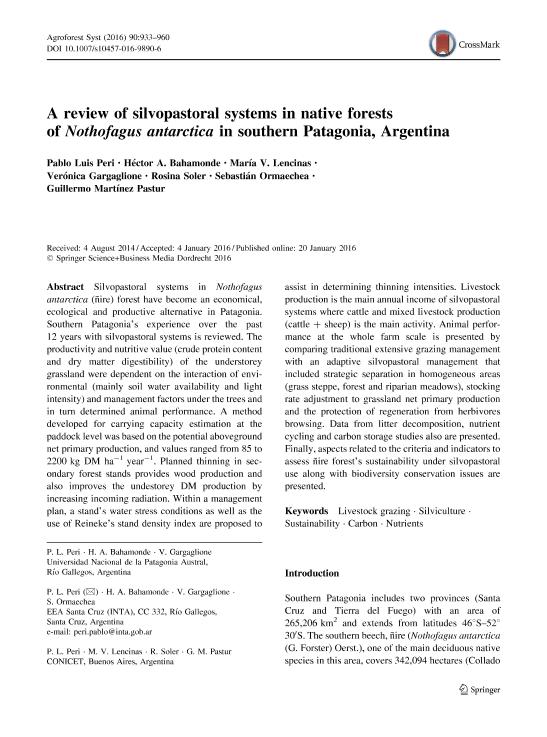Mostrar el registro sencillo del ítem
dc.contributor.author
Peri, Pablo Luis

dc.contributor.author
Bahamonde, Héctor Alejandro

dc.contributor.author
Lencinas, María Vanessa

dc.contributor.author
Gargaglione, Veronica Beatriz

dc.contributor.author
Soler Esteban, Rosina Matilde

dc.contributor.author
Ormaechea, Sebastián Gabriel

dc.contributor.author
Martínez Pastur, Guillermo José

dc.date.available
2018-04-19T20:31:31Z
dc.date.issued
2016-01
dc.identifier.citation
Peri, Pablo Luis; Bahamonde, Héctor Alejandro; Lencinas, María Vanessa; Gargaglione, Veronica Beatriz; Soler Esteban, Rosina Matilde; et al.; A review of silvopastoral systems in native forests of Nothofagus antarctica in southern Patagonia, Argentina; Springer; Agroforestry Systems; 90; 6; 1-2016; 933-960
dc.identifier.issn
0167-4366
dc.identifier.uri
http://hdl.handle.net/11336/42764
dc.description.abstract
Silvopastoral systems in Nothofagus antarctica (ñire) forest have become an economical, ecological and productive alternative in Patagonia. Southern Patagonia’s experience over the past 12 years with silvopastoral systems is reviewed. The productivity and nutritive value (crude protein content and dry matter digestibility) of the understorey grassland were dependent on the interaction of environmental (mainly soil water availability and light intensity) and management factors under the trees and in turn determined animal performance. A method developed for carrying capacity estimation at the paddock level was based on the potential aboveground net primary production, and values ranged from 85 to 2200 kg DM ha−1 year−1. Planned thinning in secondary forest stands provides wood production and also improves the undestorey DM production by increasing incoming radiation. Within a management plan, a stand’s water stress conditions as well as the use of Reineke’s stand density index are proposed to assist in determining thinning intensities. Livestock production is the main annual income of silvopastoral systems where cattle and mixed livestock production (cattle + sheep) is the main activity. Animal performance at the whole farm scale is presented by comparing traditional extensive grazing management with an adaptive silvopastoral management that included strategic separation in homogeneous areas (grass steppe, forest and riparian meadows), stocking rate adjustment to grassland net primary production and the protection of regeneration from herbivores browsing. Data from litter decomposition, nutrient cycling and carbon storage studies also are presented. Finally, aspects related to the criteria and indicators to assess ñire forest’s sustainability under silvopastoral use along with biodiversity conservation issues are presented.
dc.format
application/pdf
dc.language.iso
eng
dc.publisher
Springer

dc.rights
info:eu-repo/semantics/openAccess
dc.rights.uri
https://creativecommons.org/licenses/by-nc-sa/2.5/ar/
dc.subject
Livestock Grazing
dc.subject
Silviculture
dc.subject
Sutainability
dc.subject
Carbon
dc.subject
Nutrient
dc.subject.classification
Agricultura

dc.subject.classification
Agricultura, Silvicultura y Pesca

dc.subject.classification
CIENCIAS AGRÍCOLAS

dc.title
A review of silvopastoral systems in native forests of Nothofagus antarctica in southern Patagonia, Argentina
dc.type
info:eu-repo/semantics/article
dc.type
info:ar-repo/semantics/artículo
dc.type
info:eu-repo/semantics/publishedVersion
dc.date.updated
2018-04-18T14:54:06Z
dc.journal.volume
90
dc.journal.number
6
dc.journal.pagination
933-960
dc.journal.pais
Alemania

dc.journal.ciudad
Berlín
dc.description.fil
Fil: Peri, Pablo Luis. Instituto Nacional de Tecnología Agropecuaria. Centro Regional Patagonia Sur; Argentina. Universidad Nacional de la Patagonia Austral. Unidad Académica Río Gallegos; Argentina. Consejo Nacional de Investigaciones Científicas y Técnicas. Centro Austral de Investigaciones Científicas; Argentina
dc.description.fil
Fil: Bahamonde, Héctor Alejandro. Instituto Nacional de Tecnología Agropecuaria. Centro Regional Patagonia Sur; Argentina. Universidad Nacional de la Patagonia Austral. Unidad Académica Río Gallegos; Argentina
dc.description.fil
Fil: Lencinas, María Vanessa. Consejo Nacional de Investigaciones Científicas y Técnicas. Centro Austral de Investigaciones Científicas; Argentina
dc.description.fil
Fil: Gargaglione, Veronica Beatriz. Consejo Nacional de Investigaciones Científicas y Técnicas. Centro Austral de Investigaciones Científicas; Argentina. Instituto Nacional de Tecnología Agropecuaria. Centro Regional Patagonia Sur; Argentina. Universidad Nacional de la Patagonia Austral. Unidad Académica Río Gallegos; Argentina
dc.description.fil
Fil: Soler Esteban, Rosina Matilde. Consejo Nacional de Investigaciones Científicas y Técnicas. Centro Austral de Investigaciones Científicas; Argentina
dc.description.fil
Fil: Ormaechea, Sebastián Gabriel. Instituto Nacional de Tecnología Agropecuaria. Centro Regional Patagonia Sur; Argentina
dc.description.fil
Fil: Martínez Pastur, Guillermo José. Consejo Nacional de Investigaciones Científicas y Técnicas. Centro Austral de Investigaciones Científicas; Argentina
dc.journal.title
Agroforestry Systems

dc.relation.alternativeid
info:eu-repo/semantics/altIdentifier/doi/http://dx.doi.org/10.1007/s10457-016-9890-6
dc.relation.alternativeid
info:eu-repo/semantics/altIdentifier/url/https://link.springer.com/article/10.1007/s10457-016-9890-6
Archivos asociados
